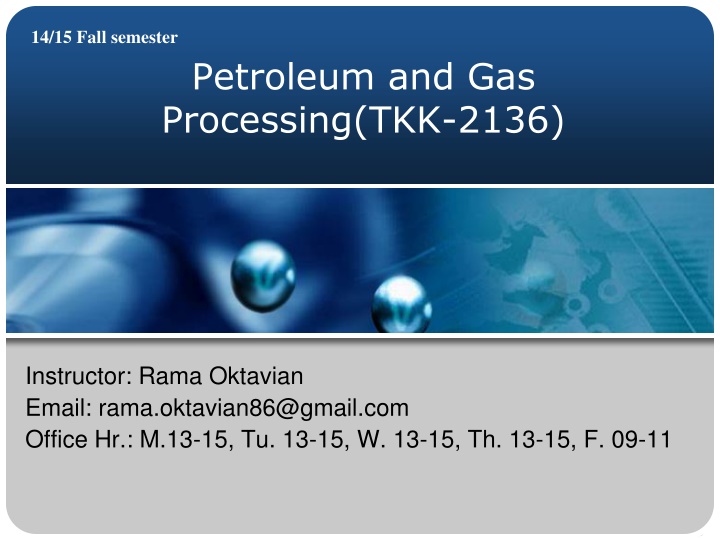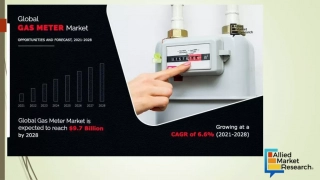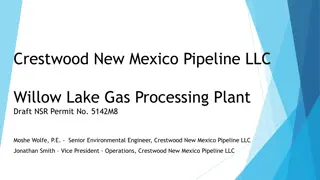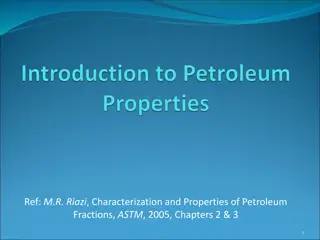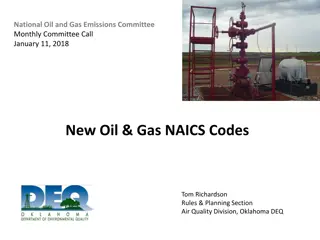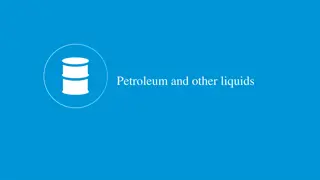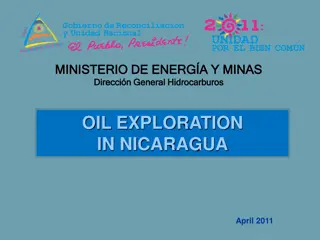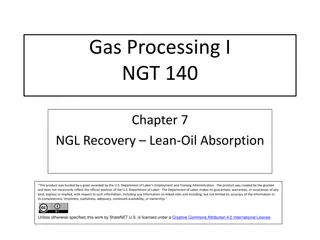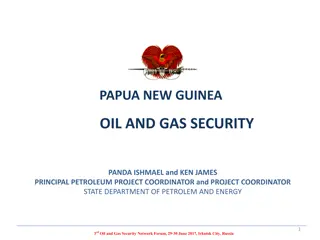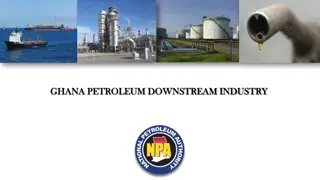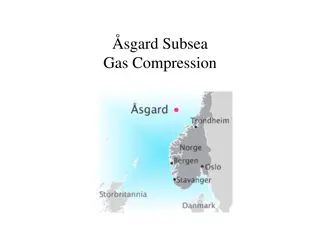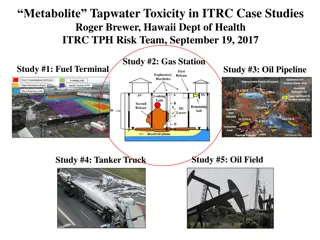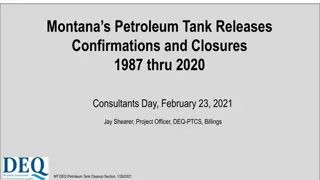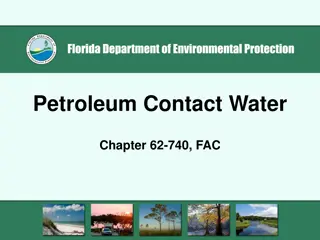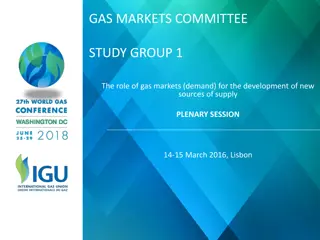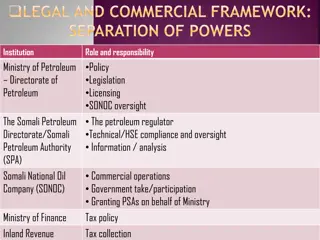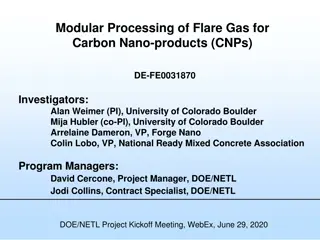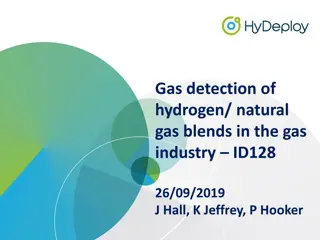Petroleum and Gas Processing (TKK-2136)
Dive into the world of catalytic reforming in the petroleum and gas processing field with a focus on reformer configurations, material balances, and isomerization. Explore the catalytic reforming process, feed characterization, octane number research, and the crucial role of reformers in gasoline production. Uncover the reforming reactions involved and understand the significance of the catalytic reformer unit in refineries.
Download Presentation

Please find below an Image/Link to download the presentation.
The content on the website is provided AS IS for your information and personal use only. It may not be sold, licensed, or shared on other websites without obtaining consent from the author.If you encounter any issues during the download, it is possible that the publisher has removed the file from their server.
You are allowed to download the files provided on this website for personal or commercial use, subject to the condition that they are used lawfully. All files are the property of their respective owners.
The content on the website is provided AS IS for your information and personal use only. It may not be sold, licensed, or shared on other websites without obtaining consent from the author.
E N D
Presentation Transcript
14/15 Fall semester Petroleum and Gas Processing(TKK-2136) Instructor: Rama Oktavian Email: rama.oktavian86@gmail.com Office Hr.: M.13-15, Tu. 13-15, W. 13-15, Th. 13-15, F. 09-11
Outlines 1. Catalytic reforming 2. Reformer configuration 3. Reformer material balance 4. Isomerization
Catalytic reforming Catalytic reforming process Catalytic reforming process a catalytic process which converts low octane naphthenic into higher octane reformate products. It is a highly endothermic process requiring large amounts of energy. the process of transforming C7 C10 hydrocarbons with low octane numbers to aromatics and iso-paraffins which have high octane numbers gasoline blending and aromatic rich reformate for aromatic production
Catalytic reforming Reformer feed characterization Reformer feed characterization
Catalytic reforming Reformer feed and product characterization Reformer feed and product characterization FEED PRODUCT Paraffins 30-70 30-50 Olefins 0-2 0-2 Naphthenes 20-60 0-3 Aromatics 7-20 45-60
Catalytic reforming Research Octane Number (RON) Research Octane Number (RON) the percentage by volume of iso-octane in a mixture of iso-octane and n- heptane
Catalytic reforming Role of reformer Role of reformer
Catalytic reforming Role of reformer Role of reformer The catalytic reformer is one of the major units for gasoline production in refineries. It can produce 37 wt% of the total gasoline pool. Other units - fluid catalytic cracker (FCC) - alkylation unit - isomerization unit
Catalytic reforming Reforming reaction Reforming reaction 1. Naphthene Dehydrogenation of Cyclohexanes 2. Paraffin Dehydrogenation 3. Dehydrocyclization 4. Isomerization 5. Hydrocracking Reactions 6. Coke Deposition Reforming reaction network Reforming reaction network
Catalytic reforming Calculating dehydrogenation reaction Calculating dehydrogenation reaction
Catalytic reforming Reforming reaction Reforming reaction 1. Naphthene Dehydrogenation of Cyclohexanes 2. Paraffin Dehydrogenation 3. Dehydrocyclization 4. Isomerization 5. Hydrocracking Reactions 6. Coke Deposition
Catalytic reforming Process step in catalytic reforming Process step in catalytic reforming 1. Feed preparation: Naphtha Hydrotreatment removal of the various catalyst poisons - sulfur, nitrogen, halogens, oxygen, water, olefins, di olefins, arsenic and other metals
Catalytic reforming Process step in catalytic reforming Process step in catalytic reforming 2. Preheating: Temperature Control 3. Catalytic Reforming and Catalyst Circulation and Regeneration incase of continuous reforming process 4. Product separation: Removal of gases and Reformate by fractional Distillation 5. Separation of aromatics in case of Aromatic production
Catalytic reforming Classification of process Classification of process 1. Semi-Regenerative Fixed Bed reactors 2. Cyclic Fixed Bed Reformers - Adding an extra-reactor to avoid shutting down the whole unit during regeneration. Three reactors can be running while the forth is being regenerated 3. Continuous Reformers
Catalytic reforming Classification of process Classification of process 1. Semi-Regenerative Fixed Bed reactors
Catalytic reforming Semi-Regenerative Fixed Bed reactors Reactions such as dehydrogenation of paraffins and naphthenes which are very rapid and highly endothermic first reactor
Catalytic reforming Semi-Regenerative Fixed Bed reactors Reactions that are considered rapid, such as paraffin isomerization and naphthens dehydroisomerization, give moderate temperature decline second reactor
Catalytic reforming Semi-Regenerative Fixed Bed reactors slow reactions such as dehydrocyclization and hydrocracking give low temperature decline. Third reactor
Catalytic reforming Classification of process Classification of process 1. Semi-Regenerative Fixed Bed reactors
Catalytic reforming Classification of process Classification of process 3. Continuous Reformers Licensed by CCR Platforming UOP Process Process description Process description - The catalyst moves downwards by gravity from the first reactor (R1) to the forth reactor (R4) - The catalyst is sent to the regenerator to burn off the coke and then sent back to the first reactor R1 - The final product from R4 is sent to the stabilizer and gas recovery section Process variable Process variable - operated at lower hydrogen partial pressure (PH2 = 3 bar) - reformate yield gain of nearly 10 vol%
Catalytic reforming Classification of process Classification of process 3. Continuous Reformers
Catalytic reforming Variable process Variable process 1. Catalyst type affect basic catalyst formulation (metal-acid loading), chloride level, platinum level, and activator level - The catalyst used for reforming is a bifunctional catalyst composed of platinum metal on chlorinated alumina 2. Reaction temperature control the reaction rate and product, usually operates at 560 C, above that temperature will form petroleum coke 3. Space velocity higher space velocity will decrease residence time and lower Octane number of product 4. Reactor pressure will affect to yield of product or hydrogen formation 5. Hydrogen/Hydrocarbon ratio
Catalytic reforming Catalyst type Catalyst type The catalyst used for reforming is a bifunctional catalyst composed of platinum metal on chlorinated alumina. the centre for the dehydrogenation reaction Platinum an acidic site to promote structure changes - cyclization of paraffins - isomerization of the naphthenes. chlorinated alumina
Catalytic reforming Catalyst type Catalyst type Impurities that might cause deactivation or poisoning of the catalyst include: coke, sulphur, nitrogen, metals and water. The reformer should be operated at high temperature and low pressure to minimize coke deposition.
Catalytic reforming Process comparison Process comparison
Catalytic reforming Calculating material balance in catalytic reformer Calculating material balance in catalytic reformer Yield correlations for the reformer were developed as given
Catalytic reforming Calculating material balance in catalytic reformer Calculating material balance in catalytic reformer Example Solution
Catalytic reforming Calculating material balance in catalytic reformer Calculating material balance in catalytic reformer Solution
Isomerization Isomerization of Light Naphtha Isomerization of Light Naphtha Isomerization is the process in which light straight chain paraffins of low RON (C6, C5 and C4) are transformed with proper catalyst into branched chains with the same carbon number and high octane numbers. Light naphtha from the hydrotreated naphtha (HTN) C5=80 C is used as a feed to the isomerization unit.
Isomerization Isomerization Isomerization reaction reaction Isomerization is a reversible and slightly exothermic reaction: The conversion to iso-paraffin is not complete since the reaction is equilibrium conversion limited. It does not depend on pressure, but it can be increased by lowering the temperature. However operating at low temperatures will decrease the reaction rate. For this reason a very active catalyst must be used.
Isomerization Isomerization Isomerization catalysts Two types of isomerization catalysts The standard Pt/chlorinated alumina with high chlorine content catalysts The Pt/zeolite catalyst
Isomerization Standard isomerization catalysts Standard isomerization catalysts This bi-functional nature catalyst consists of highly chlorinated alumina responsible for the acidic function of the catalyst. Platinum is deposited (0.3 0.5 wt%) on the alumina matrix. Platinum in the presence of hydrogen will prevent coke deposition, thus ensuring high catalyst activity. The reaction is performed at low temperature at about 130 C to improve the equilibrium yield.
Isomerization Zeolite catalyst Zeolite catalyst Zeolites are used to give an acidic function to the catalyst. Metallic particles of platinum are impregnated on the surface of zeolites and act as hydrogen transfer centres. The zeolite catalyst can resist impurities and does not require feed pretreatment, but it does have lower activity and thus the reaction must be performed at a higher temperature of 250 C (482 F).
Isomerization Isomerization catalyst comparison Isomerization catalyst comparison
Isomerization Isomerization yield Isomerization yield The reformate yield from light naphtha isomerization is usually very high (>97 wt%). Typical yields are given in Table
Isomerization Isomerization yield balance Isomerization yield balance
Isomerization Solution Solution Isomerization yields
